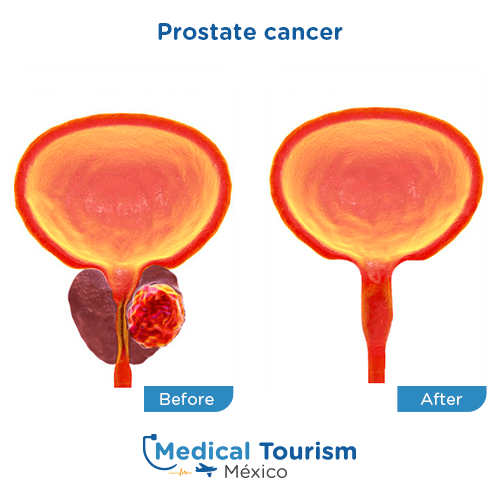The most reliable doctors in Mexico
Prostate cancer information and locations in Mexico
Prostate cancer begins when cells in the prostate start growing out of control. The prostate is
a small walnut-shaped gland located in the pelvis area next to the bladder of the male body.
Prostate cancer is the second-leading cause of cancer death for men in the U.S
There are two types of growth in the prostate; benign growth (PBH) and malignant growth
(cancer). No one knows why or how prostate cancer starts. Regular prostate exams or screenings
are the best way to help detect cancer early.
Surgery to remove prostate cancer consists of the partial or complete removal of the prostate and its surrounding tissue, as well as reconstructing the urethra and bladder.
There are three common methods of radical prostatectomy, the most noticeable differences between them are the ways to access the prostate, the recovery times, and the duration of the procedures.
Surgery to remove prostate cancer consists of the partial or complete removal of the prostate and its surrounding tissue, as well as reconstructing the urethra and bladder.
There are three common methods of radical prostatectomy, the most noticeable differences between them are the ways to access the prostate, the recovery times, and the duration of the procedures.
Types of radical prostatectomy
Robotic laparoscopic prostatectomy
This procedure is done assisted with a robotic system to remove the prostate. The
surgeon sits at a remote-control console to control the motion of the laparoscopic
surgical instruments. The console displays a magnified 3D vision of the surgical area
allowing the surgeon to visualize the organs and tissues in much greater detail.
Laparoscopic radical prostatectomy - LRP
The prostate is removed using special tools inserted through very small incisions made
in the lower abdomen. After carefully dissecting the prostate gland from the surrounding
nerves and blood vessels, the surgeon removes the prostate along with nearby tissue.
Open radical prostatectomy
The surgeon does an incision above the pubic bone, on the lower belly. Then, after
carefully dissecting the prostate gland from the surrounding nerves and blood vessels
the surgeon removes the prostate along with nearby tissue.
Benefits
Treats cancer
Can help if you need more treatment
Good option if the cancer hasn’t spread
Can help if you need more treatment
Good option if the cancer hasn’t spread
Prostate cancer
Procedure:
2 hrs.
Hospital stay: 2 hrs.
Cleared to fly: 3 - 7 days
Hospital stay: 2 hrs.
Cleared to fly: 3 - 7 days
After surgery
Out of town patients’ follow-ups can be scheduled with the urologist or any specialist after 42 days of the prostate
cancer surgery. Patients are clear for flying after 3 - 7 days from the prostate cancer surgery.
Note: Follow-ups can be arranged as face-to-face or virtually. If needed, you can go to your primary care physician to remove sutures or get medication adjustments.
As an Amazon Associate, we earn from qualifying purchases.
Take a look at one of our medical tourism essentials for urology surgery.
Take a look at one of our medical tourism essentials for urology surgery.
Before and after images
View additional images for this procedure.

View more


Locations
Select the city of your choice to seethe doctors profile.
Cancún, Q. Roo.
Dr. Rodrigo González
View more

Prostate cancer frequent questions
Get answers to our most frequently asked questions.
How do I prepare for surgery?
Some of the common specifications include stopping smoking completely, avoid food or drinks before surgery, and stop taking some medications.
How long will recovery be?
Most patients can return to their normal routines in 4 or 6 weeks. Patients need to use a urinary catheter for 10 days after surgery.
When can I resume sexual activity?
After surgery, erectile function can take 18 months to fully recover.
Recent news
Disclaimer: This information does not reflect the medical advice from our clinics. All cases are different and this treatment may not suit you. Always refer to a medical professional with the certification and experience. All of our physicians are fully qualified to perform these procedures. For more information and diagnosis contact one of our top specialized clinics.
In all medical procedures, there are chances of complications, the specialist will provide you detailed information about the risks of the procedure, talk to the specialist directly.
In all medical procedures, there are chances of complications, the specialist will provide you detailed information about the risks of the procedure, talk to the specialist directly.





